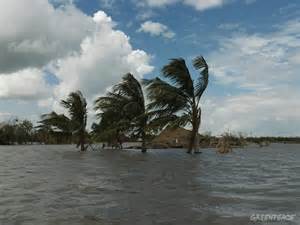
by Carrie Stevenson | Jul 6, 2018
Climate change. Those two simple words have the power to bring about a strong reaction in people. For many, the term is fraught with emotion—with worry, anger, and fear of the unknown. For others, these two words might elicit doubt or frustration. According to a multi-year, nationwide study conducted by George Mason and Yale Universities, as a country we react to the science of climate change along a spectrum of responses. On one end of the spectrum, people are “alarmed” (see a change in climate as a reality and taking action about it) and “concerned” (believe it is a serious issue but have not taken action). In the middle are those in different stages of understanding or awareness of climate issues, and characterized as “cautious”, “disengaged”, or “doubtful.” At the opposite end of the spectrum are the “dismissive”, which are that group of people who are actively opposed to action on climate change and may feel it is a conspiracy. These six categories were based on the responses of a large, in-depth survey conducted in 2008. Ten years later, researchers conducted the study again to see if attitudes had changed. Interestingly, they had—with the most noticeable shift out of the “disengaged” category, as people seemed to cast their lot with one side or the other.
| 2008/2009 |
Yale/George Mason Study Results |
2018 |
| 18% |
Alarmed (+3) |
21% |
| 33% |
Concerned (-3) |
30% |
| 19% |
Cautious (+2) |
21% |
| 12% |
Disengaged (-5) |
7% |
| 11% |
Doubtful (+1) |
12% |
| 7% |
Dismissive (+2) |
9% |
Table 1. 10-year comparison of “Global Warming’s Six Americas” Study. Source: http://climatecommunication.yale.edu/about/projects/global-warmings-six-americas/
Looking at the data, respondents left the “disengaged” group and moved either towards doubtful and dismissive or towards the cautious category. It is likely that the 3% change out of “concerned” moved directly into “alarmed”, as extreme weather events and record temperatures over the last 10 years brought the impacts of a changing climate closer to home.
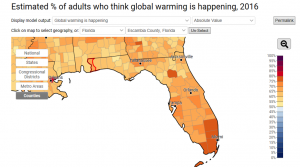
Data from a national study shows the level of agreement/disagreement on climate-based issues. Source: Yale/George Mason University
When the study is broken down by region, a minority of northwest Floridians believed human activities such as carbon emissions caused climate change. However ~65% of the same group believed climate change was happening (regardless of cause), and 80% responded that our country should fund research looking into renewable energy. The good news here is that while many of us do not agree on the cause of climate change, the majority of us agree on positive steps forward that may relieve some of its results.
For me, the take-home message of this study is that scientific understanding—on many issues, not just climate—is often along a spectrum based on exposure to research, personal interest/relevance, and cultural influences. When explaining any science-based concepts, it is important to know where your listener is coming from and start from there. It is unfortunate that we are in a time when many principles of science are taken as political positions and not products of unbiased scientific method. That being said, great thinkers from Galileo to Hawking have had their run-ins with popular opinion.
As the summer heat cooks on and hurricane season warms up, there will be more articles in the news about climate and its effects. When reading these, look at the source and their intent. Is this an opinion piece/blog with deeply emotional photos and stories meant to sway readers one way or the other? Or is it an agency page, reporting factual data? Time-tested agencies like the National Weather Service (NWS), National Oceanic and Atmospheric Administration (NOAA) and National Aeronautic and Space Administration (NASA) have been keeping historic records of climate data and satellite imagery of ice cover for decades. Use their information to inform yourself, no matter where you might fall upon the “six Americas” spectrum. Worldwide data for climate has been kept since 1880, and both NASA and NOAA climate data found:
- 2016 was the hottest year globally on record
- 2nd and 3rd hottest years on record were 2015 and 2014.
- 16 of the 17 warmest years documented since 1880 have been since 2001
For more information on climate science, check out these resources: Intergovernmental Panel on Climate Change, NOAA Climate, and NASA Climate.
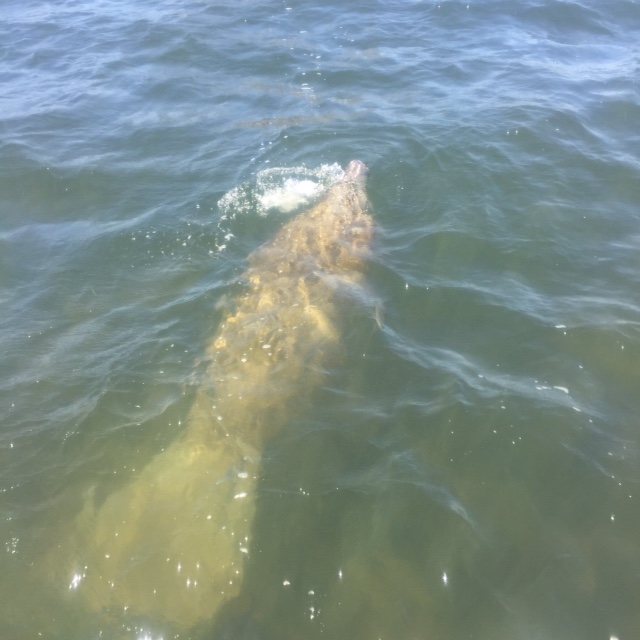
by Rick O'Connor | Feb 16, 2018
As a young boy growing up here in the panhandle, I had heard of this thing called a manatee – but had never seen one. They came more into the light when I was a teenager and becoming interested in marine biology. I was the president of the high school marine biology club and one of our goals was to raise money for a trip to Crystal River to snorkel with them. The Save the Manatee Club originated in that time trying to bring more awareness to the plight of this endangered Floridian and at one point, Jimmy Buffett had led the way.
I had learned a lot about them, found out their original range was from North Carolina south to the Caribbean and the entire Gulf of Mexico, but were now down to about 1000 animals and those were found in Florida. Eventually I did get to see manatees, and have snorkeled with them many times, but still thought of them as a south Florida animal – rarely found in the panhandle.
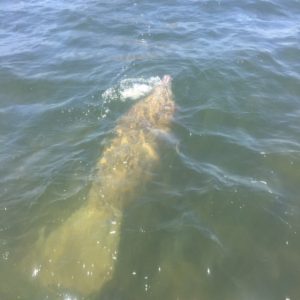
Manatee swimming in Big Lagoon near Pensacola.
Photo: Marsha Stanton
Then the recent news report – two dead manatees in the last two weeks. One washed ashore in Okaloosa county and the other in Escambia. Probably victims of the recent cold fronts. It is not unheard of finding manatees in the panhandle in recent years. I recall since the 1990’s a manatee seen in Bayou Texar in Pensacola. In another year, one was seen near Ft. Pickens. My son worked at a local marina and saw at least one a year there. There have been so many seen in the Mobile Bay area that Dauphin Island Sea Lab now has a Manatee Watch program. There are about 40 individuals that now visit Wakulla Springs. In addition, this summer there were two separate groups living in the Pensacola area. One group was residing near Gulf Breeze and a second group of about eight animals was frequently seen near Perdido Key. These once rare animals in the panhandle are now being found each year, and sometimes in groups.
What is going on?
Why are manatees beginning to visit our area?
Your first hunch would be climate change. Manatees are marine mammals but unlike their dolphin cousins their blubber layer is not as thick and they must seek warm water refuge during the winter months. When water temperatures drop below 67°F, they locate the warm water springs found in central Florida – or move south Florida where the water remains comfortable year round. If they are remaining here, could the average water temperatures have warmed enough for them to make this move?
Along this same line, mangroves are now being found in the panhandle. Both red and black mangroves have been found growing in local estuaries. In the Apalachicola area there have been quite a few located. In the western panhandle there a few individuals here and there. Further west they are found on the islands of Mississippi and have been in the Chandeleurs for many years now. Later this spring Florida Sea Grant will be conducting surveys in each county to see where these tropical trees may be growing.
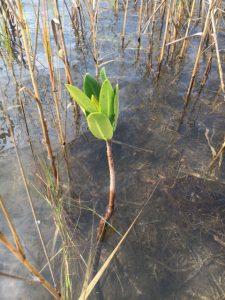
A small red mangrove growing in Big Lagoon near Pensacola FL
Photo: Rick O’Connor
And most recently are sightings of snook, a south Florida fish that have, though rare, been seen in the northern Gulf of Mexico. No doubt this Januarys hard freezes probably killed the mangroves that were here, and probably the two manatees washed ashore recently, but it will be an interesting time to see what other tropical species begin their slow migration northward. If it does happen, what will that mean? How will these changes impact local ecosystems? At this point, I am not sure if it will happen or, if it does, how fast – but it will be interesting.
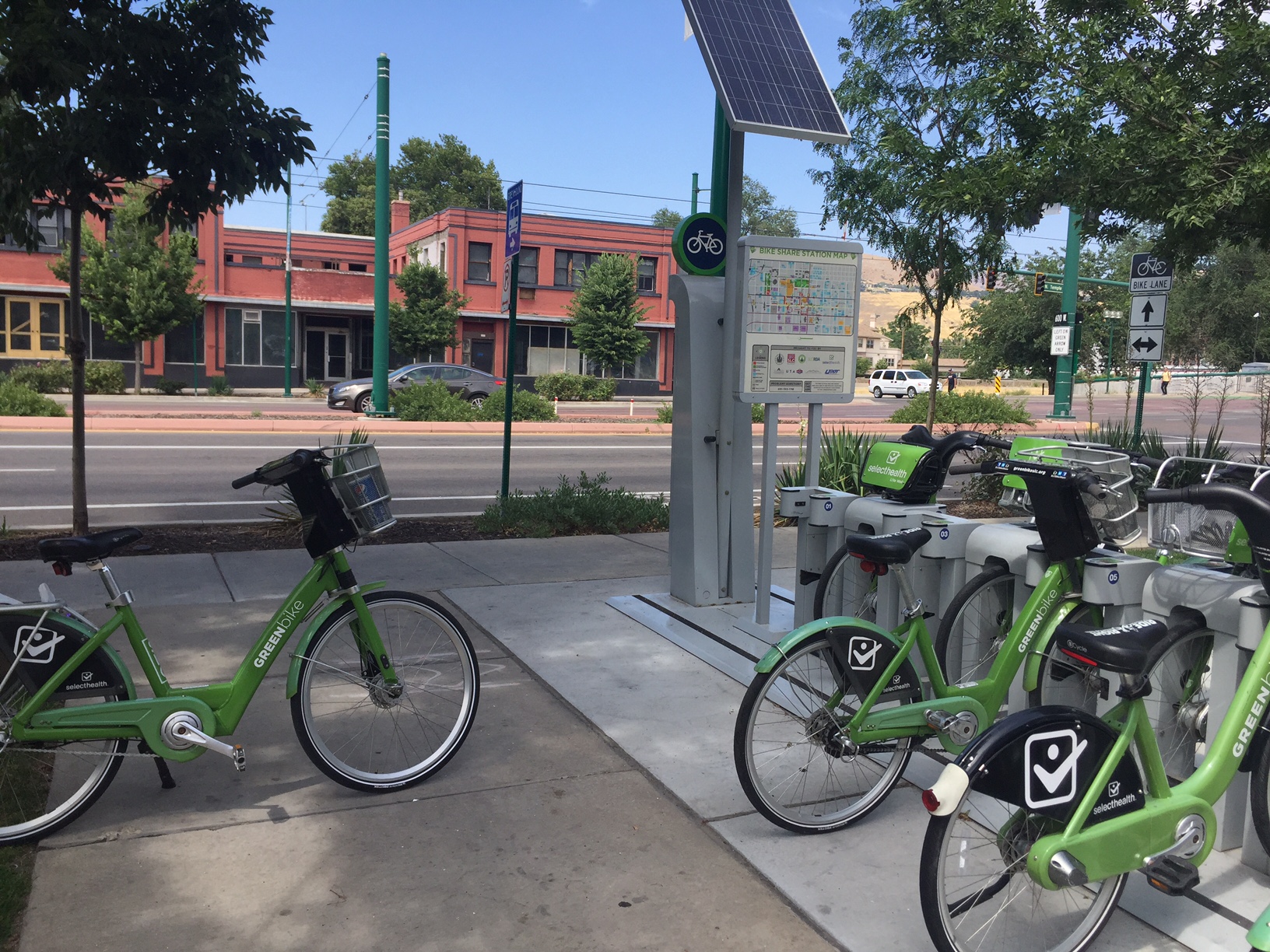
by Carrie Stevenson | Jul 14, 2017
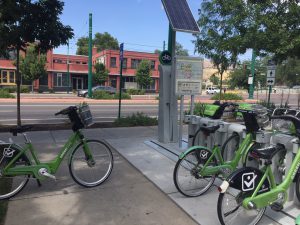
This solar-powered bicycle rental facility provides a healthy alternative to driving around a large city. Photo credit: Carrie Stevenson, UF IFAS Extension
Climate change is one of those topics that most people don’t want to think much about. It can be overwhelming, it can be controversial, and it can be downright frightening. A year ago, Yale and George Mason University completed the most recent surveys in the “Six Americas” study, which determined levels of belief and concern in global warming. The “Six Americas” range from people who are alarmed, concerned, cautious, disengaged, doubtful, or dismissive when asked about climate change. Interestingly enough, 34% of Americans consider themselves concerned while 23% were cautious. Ranking third were 11% who are doubtful about climate change.
When you start to drill down into the individual questions asked on the survey, you see more agreement. For example, when Escambia County citizens were asked whether global warming is caused by human activities, somewhere between 45%-50% said yes. However, when asked whether they think global warming is actually happening (regardless of cause), the percentage went up to 65%-70%. When asked if they support funding research into renewable energy sources, Escambia County residents jumped up to an 80%-85% agreement. That, to me, is nothing short of a miracle, having lived in Escambia County long enough to know there’s rarely that much agreement on anything!
The takeaway message from that survey, to me, is that regardless of where people stand on climate change/global warming, there are some starting points that can be common ground. If the majority of a community believe climate change is happening and that supporting renewable energy research is a good thing, then they can work towards those outcomes to the mutual benefit of all.
An example of one small but significant step towards sustainable energy use includes bicycle share/rental facilities. On a recent trip to Salt Lake City, solar-powered bike stations were strategically placed around the downtown area. For a small fee, the bicycles could be checked out (for 30 minutes at a time) up to 24 hours. This ensures there are plenty of bicycles available for other users, and stations are close enough to one another that it’s easy to check bikes in and out if you need more time. The benefits of encouraging bicycles are numerous; reduced traffic and burning of fossil fuels, reduced need for parking in high-value real estate, and health benefits for riders. The other investment necessary to make biking more prevalent and successful are bike lanes, which were plentiful in Salt Lake City to keep riders and drivers safe. Once safe bike lanes are in place, those who live in the area with their own bikes are more likely to use them on a regular basis, further decreasing vehicular traffic.
There are many great organizations and publications around the country dedicated to increasing bicycle use and safety. For more information, check out Trail Link, Momentum Magazine, or the Burlington Bikeway.

by Rick O'Connor | Feb 18, 2017
It was February 13, 2017 and the temperature was 74°F… 74! It has been one strange winter. The azaleas in my yard have already bloomed, friends of mine have seen butterflies already forming chrysalis, and I have already had to deal with mosquitos; all of this in February. But, even as we talk about how warm this winter has been in the panhandle, they are having record snowfall in the Midwest and Northeast. It has been a strange winter.

Azaleas typically bloom near Easter. These bloomed in mid-February in 2017.
Photo: Rick O’Connor
It is easy to change this discussion to climate change, but we have had weird winters before. There was the winter when George Washington crossed the Delaware, apparently colder than normal for that part of the country that year. I remember as a kid having to wear a heavy coat to school in the winter and frost was on the ground most mornings – I grew up in the panhandle by the way.
In the book Sea Level Rise in Florida; Science, Impacts, and Options, Dr. Albert Hine (University of South Florida) explains why these periodic cold and warm years occur. Our orbit around the sun is not a perfect circle; the elliptical path can adjust our distance and change the amount of solar radiation we receive from Mother Sun. Then there is the wobble effect. The rotation of the Earth on its axis is similar to a spinning top, and the wobble can alter the amount of solar radiation we receive. These orbits and rotations explain the ice age and warm periods have experienced, and Dr. HIne provides geologic evidence that supports these climate change periods. The weird thing is, based on our current orbit/rotation pattern we should be in a cooling period and heading towards an ice age. But we are not, actually the last three years have been the warmest on record. So, if the stars say we should be heading towards a cooling period, and it is warming, the question begs – why?
Well, Dr. Hine suggest that it must be our activities. Man has made so many changes that have affected our planet in so many ways that some are saying we are in a period of the Earth’s history they are calling “Anthropocene”. It is hard to argue with it. Look out your window next time you are flying and see how we have changed the landscape. You cannot see these changes as you fly over the ocean, but the changes are there. Warm surface water usually overrides cooler waters at depth. The circulation of warm and cold water due to differences in density cause the currents, which cause the wind patterns, which effects our climate. The ocean is a great absorber of heat, and it is doing just that – absorbing heat, which is now reaching deeper depths. This will certainly effect the currents and the climate. Most will point at the use of fossil fuels as the change that has had the biggest impact on all of this.
So, if this is the case, what do we do about it?
Well there are models predicting what the future climate and sea levels might be, based on potential use of resources. There is nothing, at the moment, that suggest we are going to do anything different in how we use these resources so we can expect these climate changes to continue. Will 2017 follow the current trend and become the warmest year on record yet? Will flowering plants alter their cycles based on temperatures? Are rainfall patterns going to change? Will tropical species, including invasive ones, be able to colonize north Florida? I am not sure, but I think we should consider these possibilities as we plan for our future use of the landscape. Until then, we should enjoy the nice February we are having, and hope July and August are not too bad. We will see what next year brings.
If you are interested in reading more about the science of Florida’s climate, I recommend reading
Seal Level Rise in Florida; Science, Impacts, and Options. Hines, Chambers, Clayton, Hafen, and Mitchum. 2016. University Press of Florida. ISBN 9780813062891.
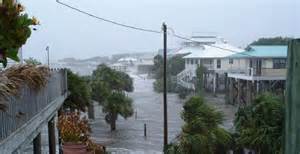
by Rick O'Connor | Sep 23, 2015
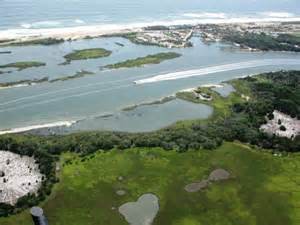
This area along Florida’s east coast is experiencing coastal flooding.
Photo: University of Florida
As we come towards the end of National Estuaries Week we will now look at some issues our estuaries are facing. Sea level rise is one that generates a variety of responses from the public. For some it is of concern, something we need to be planning for and need to spend more research dollars on to improve our models to understand it. For others, it is a problem for the back burner; yea, it is happening but the changes are over a long period of time and the serious impacts will not occur for a while – and we have more pressing issues to deal with. The old “it’s not a problem until it’s a problem” form of planning. Others still understand it but do not believe the models and do not believe the impacts will be very serious – thus warrants little or no planning. And there are those who do not believe climate change and sea level rise is actually occurring. They see no tangible evidence of any changes. Each year feels like the last – it just is not happening.
A couple of years ago I was part of a team that conducted a series of focus group meetings with residents and businesses who live and work on our barrier islands. The focus of the discussion was to determine what the coastal residents were most concerned about in terms of climate change, sea level rise, and coastal resiliency. The majority of the participants did not deny climate change but were not concerned about planning for it at this time; they had other issues were more pressing… like coastal flooding and the national flood insurance plan – which plans to increase rates for properties in flood prone areas. Ironically, this issue is tied to climate change and sea level rise. They were more concerned about it than they realized. And we did have a few who asked the question – “is there any science that supports the notion of climate change?” Let’s start there… is there any science to support this?
Yes… this link to NASA (http://climate.nasa.gov/evidence/) is a page developed to help the public better understand what the science says about this. Yes, there is evidence that the carbon is increasing in our atmosphere, that global temperatures are rising, as are sea levels. Many are experiencing some of the changes that were discussed in the 1980’s. Some areas are seeing more rain, others more drought. Gardeners in parts of the country are noticing that things they use to do in April, they now do in March. More tropical plants and animals are migrating north – there are at least three records of red and black mangroves growing the Florida panhandle and a snook was caught a couple of years ago at Dauphin Island, Alabama. These subtle changes have been noticed by some. Others, such as those in southeast Florida, have witnessed more direct evidence, such as portions of A1A going underwater during extreme high tides. But there is science to support this.
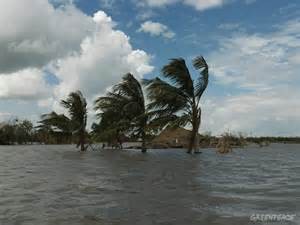
Islands in the south Pacific who are dealing with the impacts of sea level rise during storm events.
Photo: Greenpeace
What is causing sea level rise?
Well, according to a document published by Florida Sea Grant there are three general causes.
- Temperature – as the atmosphere and oceans warm the water expands thus causing the sea level to rise. This thermal expansion has accounted for about 25% of the sea level rise we have witnessed; between 1993 and 2010 it accounted for 40% of it.
- Ice melt – 60% of the current rise in sea level has been due to the melting of land based ice; such as glaciers.
- Land fall – for a variety of reasons, some coastal land masses have actually dropped; thus forcing the sea level to rise.
What do the current models predict for future sea level rise?
Most of the models are predicting an increase between 1.5 and 4.5 feet, depending on where you are, by 2100.
So what?
Again some coastal communities are experiencing impacts now. South Florida Water Management District is currently replacing all of their gravity flow drains due to the fact that sea level has risen enough that they only work at low tide. Monroe County (Florida Keys) is now replacing their vehicles at a faster rate due to constant driving through salty flood waters. Many Florida coastlines are now experiencing saltwater intrusion of their freshwater supply. This is partially due to the over consumption of that resource but it is also due to sea level rising introducing salt water to these systems. There has been increased flooding in many parts of the country, including the Florida Panhandle.
So what does this mean for our local estuaries?
As we have said, sea level rise has occurred before – will this be a problem for our estuarine habitats? Generally ecosystems adjust to environmental change over time but they cannot respond if these changes occur too fast. Scientists have determined that an increase of 0.13” of sea level/year will flood our coastal marshes and we may lose them; currently the rate is about 0.11”/year. It is believed that our barrier islands will “roll” landward but science is not sure how fast this will happen. There may be changes in species composition within our estuaries – which could be good or bad – and there is certainly room for the expansion of invasive species.
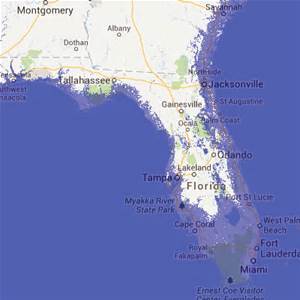
A graphic indicating the potential flooding of Florida.
Graphic: Green Policy 360
How has government responded?
Federal and county governments have responded – the state… not so much. According to Thomas Ruppert (Florida Sea Grant) the local governments have done the best job planning for these future changes. Many areas in the state now require some form of sea level rise planning in all new development projects. At the very least coastal communities should look at future development plans and think long term as to where flooding may become a bigger issue.
“The times they are a changing…”













